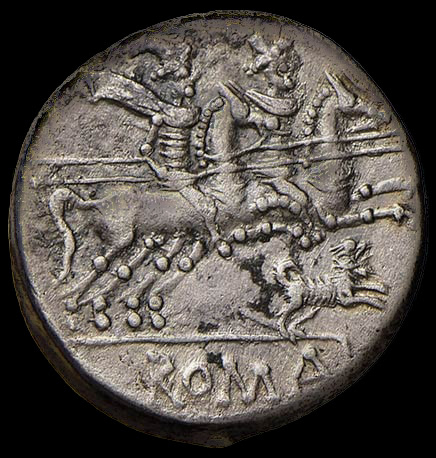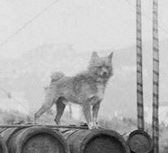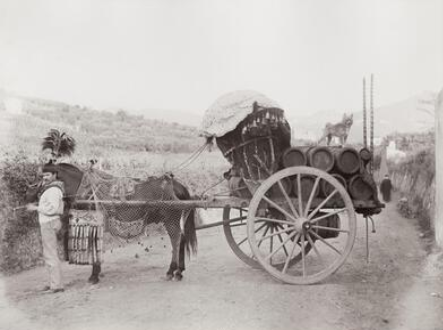The documented history of the Italian Volpino is a long journey from the 4th century B.C. until today.
Let's start from the very beginning:
ORIGIN
Italian Volpino is the most recent name for this breed, which is at least 2,500 years old (though it could be even older). It originated in ancient Greece and Rome. Numerous artistic depictions and literary sources show and describe a small to medium-sized, fox-like dog with erect ears, a curled tail, and medium-long fur. These dogs were undoubtedly the direct ancestors of modern medium and small Spitz-type breeds, including the Italian Volpino. The ancient Romans called them Melitaeus Catulus, while the ancient Greeks referred to them as Melitaion Kunidion. They were primarily kept as pets, but they also served as effective watchdogs and capable mousers.
Let's examine some ancient evidence of these dogs in Italy:
Red figured amphora with handles
Vulci 480 B.C.
Currently held at The British Museum
Image dating the Etruscan Era in Tuscany (Italy)
400BC
Image from the italian Book
Annali dell'Instituto di corrispondenza archeologica 1829
Terracotta Hellenistic rhyton from Puglia (Italy). Late 4th–early 3rd century B.C. Currently held at the Metropolitan Museum.
Terracotta rhyton in the shape of a dog’s head ca. 350–300 B.C.
Puglia (Italy) Currently held at the Metropolitan Museum.
Terracotta rhytonin the shape of a dog’s head (vase for libations or drinking) ca. 350–300 B.C.
Puglia (Italy) Currently held at the Metropolitan Museum.
Chous , Puglia (Italy) 360 B.C.-350 B.C.
Currently held at The British Museum.


Etruscan Coin
300 B.C.
Terracotta found in Egypt (Roman period)
400-100 B.C.

Roman Coin (Denario)
146 B.C.

Roman Terracotta Statue Ruvo (Italy)
100BC
Currently held at The British Museum.
Fresco located in Pompeii
the date is unknown but it must be older then the 79 A.D.
Bronze Roman Ring
100 - 300 A.D.
Roman terracotta statue
100 - 300 A.C.
Roman Ivory statue
200 A.C.
Grave Stele for a dog, Italy (Rome), marble, ca. 150 – 200 A.D.
Currently held at The J. Paul Getty Museum
Aristocratic Italian Volpinos and Rustic Italian Volpinos
Italian Volpinos have been very common in Italy for centuries, appreciated by all social classes, from the wealthiest to the poorest. This widespread popularity led to the development of distinct types of Volpinos. The Italian elite and the working/poor classes had different needs for their dogs, and soon "aristocratic" and "rustic" Volpinos emerged with slight variations.
"Aristocratic" Volpinos were (and are) primarily bred for aesthetic purposes, as pets and for dog shows. "Rustic" Volpinos, on the other hand, were (and are) primarily bred for working purposes. "Aristocratic" Volpinos were (and generally still are) predominantly pure white, while "rustic" Volpinos were (and are) found in nearly every color except pure white, with red being particularly common.
Old paintings and photographs depict these different types of Volpinos in various settings.
"La visione di San't Agostino"
Vittore Carpaccio 1502
Agriculture Fair in Foggia (Italy) late 17th century A.D.
"Cagnolino, lupetto bianco"
Filippo Palizzi
1818-1899
"A Volpino Italiano and other dogs in an interior"
John Charlton 1870
"Monte Testaccio"
Charles Coleman 1850 (Rome, Italy)
Painting inside the Basilica di San Marco, Venice (Italy)
Andrea Landini 1875-1885
"L'arresto di Luisa Sanfelice"
Modesto Faustini
(1839 - 1891)
Wine cart
Charles Coleman 1850
"Il cagnolino nero"
Enrico Coleman 1846-1911
"Un pubblico attento"
Antonio Ermolao Paoletti
(1834 - 1912)
Buffaloes with block of travertine in repose
Charles Coleman 1850
"Good Dogs"
John Charton 1870
Animali da Presepe
Vecchio catalogo d'asta
1895
Enrico Coleman
1846-1911
Francesco Londonio
1723-1783
Francesco Coleman
1851-1918
Francesco Londonio
1723-1783
"Perché non dirlo?"
Giovanni Fattori
1890 ca
Held at the Gallerie degli Uffizi (Florence)
"Il plurito dell'asino"
Filippo Palizzi
1818-1899
"Parco degli Acquedotti"
Enrico Coleman 1846-1911
Rome
"Passeggiata in Via Caracciolo, Napoli"
Filippo Palizzi
1847
Postcard
Rome approximately 1950
"Il Carrettiere"
Filippo Palizzi
1818-1899
"Nella stalla"
Filippo Palizzi
1818-1899
"Ritratto di Volpino"
Carlo Ademollo
1824-1911
Wine cart
Enrico Coleman 1846-1911
Rome
"Il cane"
Viti Eugenio
1881-1952
"La bambina e il cane"
Armando Spadini
(Florence) 1883 - 1925

Farmers after WW2 in Italy
The favourite carter's dog
Until the early 19th century, before the widespread use of automobiles, transporting goods by cart was very common in Italy. As you can see in the artwork above, rustic Italian Volpinos were often depicted alongside carts. In fact, Volpinos were the preferred working dogs of carters (especially wine carters) because they were readily available and inexpensive, small and easy to transport on the cart, and excellent at deterring thieves from approaching the goods.
Wine Carters with Rustic Italian Volpinos
Rome 1890 - 1930 ca.


Shepherds and Rustic Italian Volpinos
To better protect their livestock, many Italian shepherds kept Volpinos alongside their sheepdogs. Thanks to their exceptionally keen hearing and excellent eyesight, Volpinos could quickly detect early signs of danger (especially wolves) and alert the larger sheepdogs.
The photo below, taken in the 1950s in the Abruzzo region of Italy, shows a shepherd with his six Abruzzese Sheepdogs (Cane da Pastore Abruzzese) and a rustic Italian Volpino.
Queen Victoria's Volpinos
During her visit to Tuscany (March 24th - April 22nd, 1888), Queen Victoria fell in love with the Italian Volpino and imported four of them to England: Marco, Beppo, Lina, and Gina.
On her second visit to Tuscany (March 23rd - April 26th, 1893), Queen Victoria brought more Volpinos back to England, including Turi, the white Italian Volpino pictured with her (see photo below).
Naturally, the Volpinos imported by Queen Victoria were beautiful "aristocratic" examples, purchased from Italian aristocrats.
For more details about the history of Queen Victoria's Volpinos in England, please visit:
Bred for Function vs Bred for Show
A perfect example of a Volpino with primitive functional working characteristics (Left Portrait) and a Volpino with purely aesthetic characteristics (Right Portrait).
Left Portrait:
Volpino Italiano
"Angelo Vecchio,
Il Cane, Razze mondiali, allevamento,
ammaestramento, malattie e rimedi. Milano Hoepli 1887
Manuale Hoepli"
Right Image:
Modern Volpino Italiano ENCI

Fortunately, there are few breeders still breeding Rustic Italian Volpinos looking just like the Italian Volpinos described in the 1887's book.
The dog on the right is Shada (one of our Females).